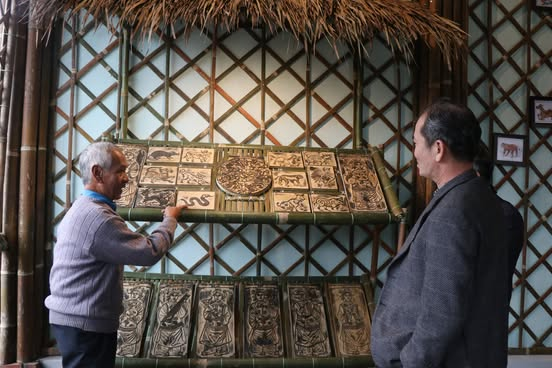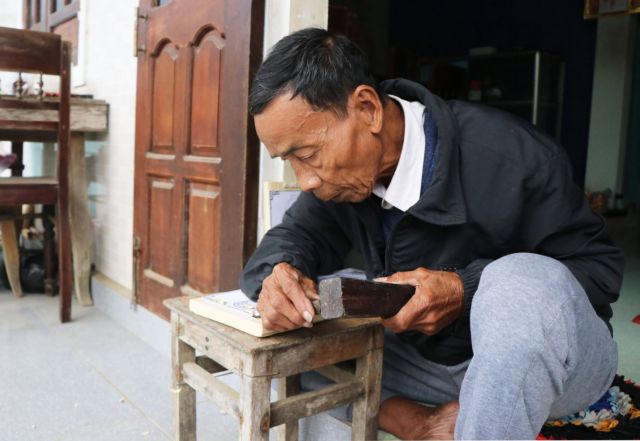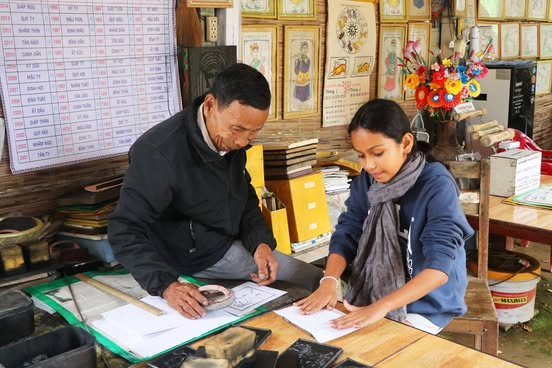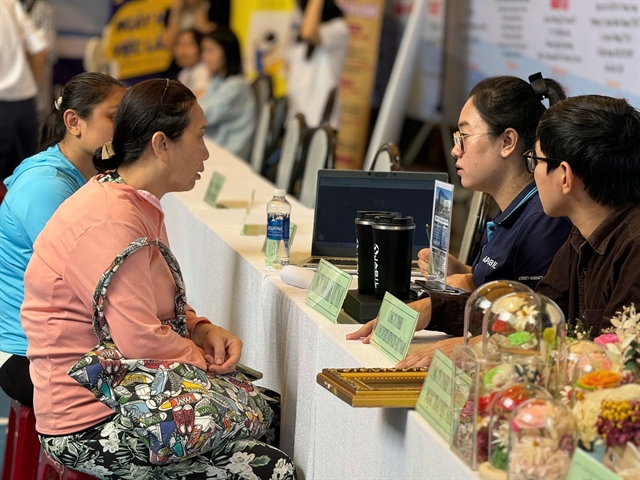 Features
Features

 |
| Several woodblocks used in making Sình Village folk paintings are on display for tourists. VNA/VNS Photos |
Each Tết (Lunar New Year) holiday, as spring approaches, Sình Village in Dương Nỗ Ward, Thuận Hóa District, Huế City, comes alive with artists crafting traditional paintings to meet the surge in demand.
With a history spanning over 400 years, Sình Village’s folk paintings are not only valued for their artistic craftsmanship but also for their deep connection to the region’s cultural and spiritual life. They are a distinctive feature of the ancient royal capital city.
The paintings of Sình stand out for their unique purpose and the distinct methods used to create them. According to artisan Kỳ Hữu Phước, a ninth-generation descendant of the village’s founders, this craft has been practised for centuries, emerging soon after the village was established.
Sình Village’s founders migrated south from the northern province of Bắc Ninh, which explains why Sình paintings share similarities with Đông Hồ paintings—an art form originating in the 16th-17th centuries. Both styles use woodblock printing techniques, poonah paper, and natural materials for colouring.
 |
| Artisan Kỳ Hữu Phước cuts a woodblock for printing pictures. |
However, their purposes differ. While Đông Hồ paintings are used for decoration, Sình Village paintings serve spiritual functions, featuring in worship ceremonies, fortune-lifting rituals, and Tết offerings. These paintings are traditionally burned after the ceremonies.
Unique features
Sình paintings fall into three main categories: character, object, and animal paintings, all primarily for worship. The production process involves several meticulous steps: trimming paper, coating it with a ground seashell mixture, printing with woodblocks, drying, colouring, and finally, the “opening the eyes” ceremony—believed to imbue spirit into feng shui objects.
Creating the seashell mixture is particularly labour-intensive. Villagers collect delicate, colourful seashells from the Tam Giang Lagoon, crush them into powder, mix with glue, and apply two layers onto poonah paper—giving Sình Village paintings their distinctive texture. Each painting is a complete woodblock print, typically carved from jackfruit or guava wood, and finished with natural pigments in blue, yellow, orange, red, black, and green.
Despite their simple, rustic style, Sình Village paintings are vivid and deeply infused with Huế’s cultural essence. More than 20 households continue the craft, ramping up production from the 10th lunar month until the lunar new year.
Preserving Huế’s cultural heritage
Throughout history, Sình Village has experienced both prosperous times—when nearly every household engaged in painting—and challenging periods when the craft risked fading away. Despite these ups and downs, villagers have remained committed to preserving the art passed down by their ancestors.
 |
| Artisan Kỳ Hữu Phước's home has become a popular destination, attracting visitors eager to explore, learn about, and experience the block printing process. |
Now nearly 80 years old, artisan Phước remains dedicated to the craft, continuously creating woodblock prints on various themes.
As a result, Sình paintings now extend beyond their ritualistic function, with decorative themes such as bát âm (a set of eight prints each depicting a traditional instrument musician), seasonal harvests, and scenes from daily life.
Artisan Phước’s home has become a popular destination, attracting visitors eager to explore the painting process.
He recalled a time when interest in Sình Village painting declined, prompting him to collect and preserve old woodblocks left by previous generations. During efforts to revive the craft, he encouraged community participation and even carved new woodblocks based on surviving originals, donating them to local households.
“My wish is to pass on the craft to younger generations so they can continue preserving this traditional art,” he said.
To safeguard and develop this unique folk tradition, local authorities are actively boosting the craft through community tourism.
Nguyễn Văn Trai, chairman of the People’s Committee [administration] of Dương Nỗ Ward, said recent initiatives focus on conserving and expanding Sình Village’s folk painting while generating jobs and boosting income for local residents.
These efforts include issuing resolutions to protect traditional crafts, collaborating with the Vocational Education and Continuing Education Centre and artisan Phước to offer training classes, and encouraging printing households to integrate folk painting with experiential tourism.
Phạm Công Khai, owner of Mộc Huy folk painting workshop in Dương Nỗ Ward, opened his facility after completing a folk painting training course. He now offers both locals and tourists the opportunity to experience the printing and colouring processes firsthand, helping to spread the unique charm of Sình Village’s folk paintings worldwide.
Sình villagers continue their tireless efforts to safeguard their artistic heritage, ensuring its survival in modern life while seamlessly integrating Huế’s rich cultural traditions into the global cultural landscape. VNS









